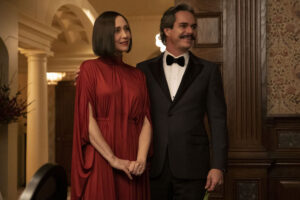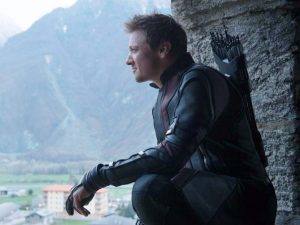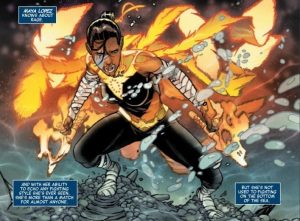SPOILERS FOR HAWKEYE EPISODE THREE AHEAD!
Of the few people who are actually talking about Hawkeye and making their opinions known on what is potentially the least-watched live-action Marvel Disney+ show yet, it seems from social media that most are just sticking around to witness the return of Vincent D’Onofrio as Wilson Fisk, better known by his supervillain alias, Kingpin. And after Hawkeye‘s third episode debuted yesterday, the series may have just ensured that Kingpin will continue to overshadow the rest of the story, much like how the character looms over everyone thanks to his impressive 6’7″ stature.

And mind you, all we see of Kingpin in episode three, in the roughly five seconds that he’s onscreen, is one of his hands, and a little bit of his suit. We hear him chuckle, but he doesn’t actually say a word to confirm that Vincent D’Onofrio is back in the iconic role. I’m excited to see Kingpin, don’t get me wrong, but it’s slightly frustrating that in five seconds he managed to pull focus away from everything else that happened in this episode, including our official introduction to Hawkeye‘s primary villain for the moment – Echo (Alaqua Cox).
To some degree, that’s on head writer Jonathan Igla and directors Bert & Bertie for not giving Cox’s adult version of Echo a standout action sequence or emotional beat, even though there were plenty of opportunities to blow audiences away on both counts. Her child version, played by Darnell Besaw, has one brief fight at a karate class that translates her photographic reflexes from page to screen, but while promising, we have yet to see Cox’s Echo utilize those abilities again. And her final scene with her father, who famously dies in the comics leaving a bloody handprint on Echo’s face, is significantly less impactful when Disney shies away from showing much blood.
But at the same time, it’s worth noting that MCU stans will find a way to overshadow Echo no matter what. Even when it was revealed that she would become the first Marvel character introduced on Disney+ to receive their own spinoff, all that anyone could talk about was how Kingpin and Daredevil could use Echo’s show as an arena in which to continue their conflict from the Netflix Daredevil series, as if Echo doesn’t have any stories worth telling from her own viewpoint.
And that’s a shame, because Echo happens to be a fascinating character, and Alaqua Cox in her debut performance brings a commanding presence to the role. A deaf Native American woman (and in the MCU, an amputee like Cox), left in the care of Kingpin after her father’s murder, Echo in the comics has a reputation as one of the most formidable street-level antiheroes in the global criminal underworld. There’s already so much going on with her in this episode that Hawkeye doesn’t even have time to reference the fact that in the comics, Echo was the original Ronin before Clint Barton (Jeremy Renner) took on the mantle.
Nonetheless, the two characters still have a very intriguing dynamic in the MCU. There’s a somewhat generic revenge storyline going on, with Echo under the (most likely false) impression that Clint as Ronin murdered her father, but what’s most compelling about their relationship to each other is how they interact as two characters with hearing disabilities. Hawkeye depicts a range of experiences through Echo, the MCU’s second deaf character after Lauren Ridloff’s Makkari in Eternals, and Clint, who has partial hearing loss.
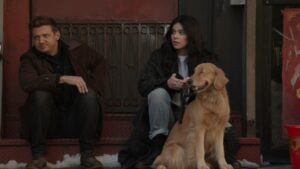
This includes depicting the stark differences between the two, as well as the similarities. Echo uses sign language and as a child had to rely on lipreading because she wasn’t able to attend a deaf school, while Clint is still in the process of learning sign language and can’t hold a full conversation with Echo without the help of a translator using simultaneous communication (or SimCom), a controversial method where one signs and speaks at the same time, sometimes to the detriment of both languages but particularly to the signed language because the speaker is often a hearing person who mentally prioritizes their spoken language even while using SimCom.
I have not been able to find any articles specifically regarding the use of SimCom in Hawkeye, and thus it would be impossible for me to say as a hearing person who doesn’t speak any sign languages whether the SimCom in the show is accurate and intelligible. But something that I have seen others address, and that I noted myself while watching this episode of Hawkeye, is that the way shots are framed, the characters’ hands are often out of frame while they’re signing. It might seem like a small thing to some, but it also demonstrates why representation can’t stop at onscreen visibility. It takes a diverse team behind the camera to make sure that visibility is…well, visible.
I do appreciate, however, that Hawkeye actually utilizes its diversity for more than just surface-level visibility; Clint and Echo’s disabilities are an integral part of both their characters, and in this episode at least both deal with unique situations and challenges that arise because of their disabilities. At one point, Clint’s hearing-aid gets smashed under Echo’s boot during a fight, which in turn requires him and Kate Bishop (Hailee Steinfeld) to work together more closely, culminating in a scene where she helps him through an abrupt phone call from his son. It’s strongly reminiscent of a scene in The Umbrella Academy‘s season one finale, but still poignant and powerful.
In the superhero genre especially, it’s also important that diverse characters get the chance to be cool, which is why Makkari’s magnificent power display in Eternals was such a joy to behold. And here, it’s great to see that Clint at least is finally being given that chance thanks to his collection of trick arrows, each more dangerous than the last. Even though it’s pretty obvious that the show’s CGI budget got diverted elsewhere (let me guess, it’s all going into making Kingpin look taller), several of the arrows are very well-used, and the Pym Tech size-alteration arrow is particularly clever in theory.
In next week’s episode, we’ll also presumably see Clint take up a sword as he deals with the Swordsman himself, Jack Duquesne (Tony Dalton), who pops up right at the end of episode three (wielding Ronin’s blade) to remind us that, oh yeah, there’s a whole separate plot revolving around that unsolved murder mystery in episode one that has yet to tie into everything going on with Echo and Kingpin. At this point, with my theory that Echo would be connected to the MCU’s Red Room officially very unlikely to materialize into anything substantial (a shame, I thought it was a good theory), I have no idea when or why Yelena Belova will show up.
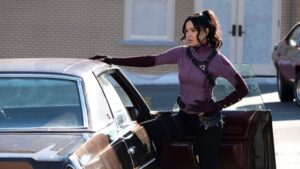
Perhaps, in trying to wrap up all these storylines with a neat little bow (and arrow), Hawkeye will bite off more than it can chew, but for the time being I’m just enjoying the ride. As long as Renner and Steinfeld continue to have great banter and chemistry, and Echo continues to develop into a more well-rounded antagonist to the duo, that shouldn’t be hard. I just have to hope that they don’t let Kingpin steal the show from them without putting up a fight.
Episode Rating: 7.5/10

